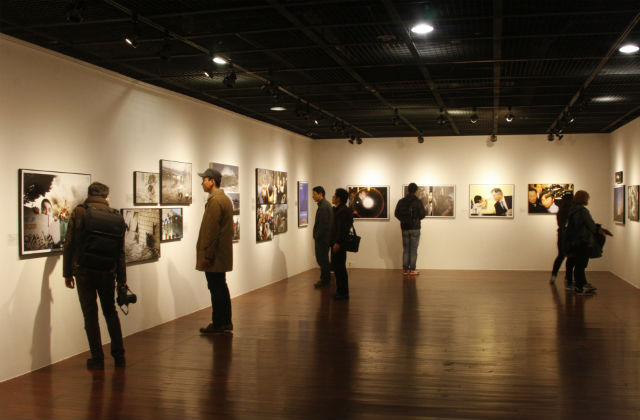The story of 2012 narrated by photojournalists

According to a CHINESE proverb “a picture is worth a thousand words.” Likewise, emotions, situations and complex ideas, all captured in one image, can often be more effective than words. They record history, and become a testimony for the general public to hear. After all, only photographs remain.
Photographing news
The news, commonly viewed as a reflection of “reality,” heavily influences our perception of the world. Reality for a 21st-century-individual is, therefore, directly constructed by the media; a reality shaped by reporters and photojournalists, who wait patiently at all times, while history slowly unfolds and awaits to be recorded. The events are portrayed as they occur, and photos are taken objectively. In the words of Ernest Haas, “With photography a new language has been created. Now for the first time it is possible to express reality by reality…when words become unclear, I shall focus with photographs.” Personal interpretations, however, remain in the hands of the public.
An annual exhibition series by the Korea Press Photographers Association (KPPA) aims to portray a year-long history through the lens of photojournalism. “Documenting Human, Recording Times,” the 49th exhibition of the series contains 170 photographs selected from the hundreds of thousands taken by professionals, categorizing them in four distinct groups: “News in Photos,” “Human Document,” “Art in Life” and “Live with Nature.” The collection of photographs published in newspapers, journals, websites and television, gives insight on the events of the past year from a new perspective: the perspective of imagery.
Photojournalism in the spotlight
The Yonsei Annals took a guided tour of the exhibition along with Hong In-kee (Photo Reporter, Hankook Ilbo), who did not hesitate to input his personal thoughts and comments on the displayed works. He began the tour from “Photojournalists in the spotlight,” a small additional section to the existing four categories, offering a general insight on the career of photojournalism. By showing both the professional and the humanistic side of the reporters, this section breaks the ice between the audience and the professionals whose portraits are displayed.
Some of the works display the photojournalists’ countless efforts to “capture the right moment,” in the midst of a crisis. Others show them at the spot of an incident, helping and taking care of others while waiting for the actual news to take place. Hong claims, “Most of the photos are evidence of events that happened within split seconds. These photographs are the results of luck combined with indefinite waiting, because that is what we photojournalists do.”
2012 through captions
It is hard to decide where one should start when describing the events of 2012. The 2012 Olympics, the 18th South Korean Presidential elections, the sudden spread of Gangnam Style, the Dokdo controversies and the disastrous typhoon “Volaven” are only a few of the major news headlines of the past year. National news from various fields such as sports, politics, economy, culture, arts, and nature that define 2012 was presented in the exhibition, told through the captions of photojournalists.
The first main section, “News in Photos,” captures incidents or accidents mainly from political and social issues.
- May 12, Cho Young-cheul. A woman pulls the hair of representative Cho Jun-ho during a scandal at Ilsan Kintex Hall.
- October 10, Cho Bo-Hwi. A sudden flood at the Cheongecheon River traps four citizens under the bridge, waiting for 15 minutes to be rescued. “Since professional cameras are too heavy, not many reporters carry them around out of work” says Hong. “Cho Bo-hwi, however, happened to be carrying his during lunch break, when he witnessed this accident happen. It was, again, luck.”
The second section, called “Human Document” consists of pictures depicting more everyday situations through concepts and settings reflecting the reporters’ imagination.
- January 4, Ang Hui-sung. Father of disabled athlete Son Byung-joon works together with his son, aiming for a chance at the London Paralympics. Their efforts paid off: Son wins the silver medal from the very first match of the tennis tournament.
- September 8, Oh Sang-min. Japanese professor Yuji Hosaka claims that Dokdo is Korean territory, and neither ethnicity nor nationality can distort the truth.
The third category, titled “Art in Life” shows the beauty of art by photographing artists, performances, sports events, fashion and architecture.
- October 4, Park Dong-joo. Psy, Gagnam Style and his horse dance spread around the globe like a virus. Singer Psy sticks to his promise by performing back in his country, in front of Seoul City Hall which was packed with fans.
- August 7, Olympic Photographers Association. After an intense match, Korean wrestler Kim Hyun-woo wins the gold medal at the London Olympics, filling our hearts with pride.
The last section, “Live with Nature,” reveals the unique beauty as well as the formidableforces of nature that change our everyday lives.
- February 14, Park Dong-wook. A tsunami cloud streaming from Mt. Jangbok, ready to take over the city of Gyeongnam.
- October 15, Jang Yong-joon. A phoenix flies across the beautiful, red sky while an airplane crosses the sunset simultaneously.
* * *
The photographs above are simply a slight glimpse of the yearlong history of 2012: a year of nationalism, a period of anxiety, and a time of renewal. These descriptions, of course, are by no means enough to express the feelings and complex situations behind each news scene. Alternatively, photographs can take the place of words, while individual interpretation replaces the classic thousand-word-articles written by others. It takes seconds to take a look at them, but their image lasts eternally in our minds. We become their witnesses, and they, our testimony.

